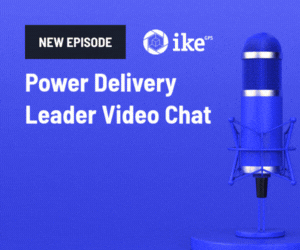Top Innovators
Jason Delaney, Kerri Carnes, and Elizabeth Lawrence represent the Virtual Power Plant team at Arizona Public Service Company.
PUF's Lori Burkhart: Jason, describe the innovation that led to your team winning the Maria Telkes Top Innovator Award for Distributed Energy, how it works, and what the benefits are to Arizona Public Service.
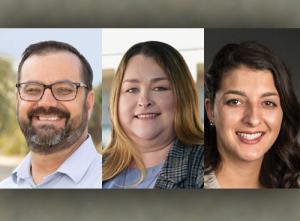
Jason Delaney: Arizona Public Service Company delivers reliable, affordable and clean energy for approximately 1.4 million customers in Arizona. The Customer to Grid Solutions team at APS serves as the bridge between what our customers want and what the grid needs by providing exceptional service and expertise to integrate innovative technologies.
The programs in our demand response portfolio help customers manage their energy use by participating in programs, while impacting the grid. Our DR portfolio includes a variety of technologies like smart thermostats, behavioral DR, and storage devices.
The team has been responsible for scaling our DR portfolio, which has grown into a Virtual Power Plant (VPP). With almost eighty thousand thermostats enrolled in Cool Rewards — a smart thermostat program for residential customers — we're capable of shedding more than one hundred ten megawatts of energy demand. That's the equivalent of a small power plant, or fifteen thousand homes. This year, we achieved more than one hundred seventy-five megawatts of capacity from our entire DR portfolio.
It's remarkable how much we've grown in the past five years and how we continue to do so by working with customers to manage energy use in ways that meet their needs even during the record-breaking heat wave we experienced this summer.
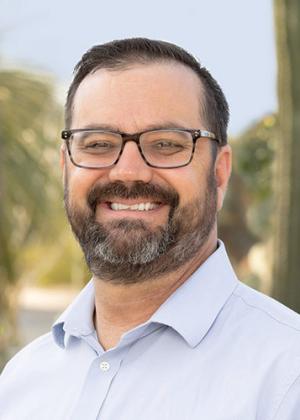 Jason Delaney: The team has been responsible for scaling our DR portfolio, which has grown into a Virtual Power Plant. With almost 80,000 thermostats enrolled in Cool Rewards – a smart thermostat program for residential customers – we’re capable of shedding more than 110 MW of energy demand. That’s equivalent of a small power plant, or 15,000 homes.
Jason Delaney: The team has been responsible for scaling our DR portfolio, which has grown into a Virtual Power Plant. With almost 80,000 thermostats enrolled in Cool Rewards – a smart thermostat program for residential customers – we’re capable of shedding more than 110 MW of energy demand. That’s equivalent of a small power plant, or 15,000 homes.
PUF: Kerri, what is your role in the development of the innovation?
Kerri Carnes: As the Director of the Customer to Grid Solutions team, our team is responsible for designing programs to benefit our customers, providing them with energy-saving options while helping to advance a cleaner, more reliable grid. We collaborate with our partners to provide customers with devices, assist customers in installing their devices, and then call on the devices for events.
Events can pre-cool homes, shifting load to our high-solar production period, and use the thermal properties of customer homes as a battery to curtail HVAC load to reduce peak demand.
Connected ENERGY STAR® products such as thermostats, heat pump water heaters, and battery storage play especially important roles because they enable both customers and APS to not only reduce energy use, but also to shift load and reduce peak demand on Arizona's hottest summer days, and shift energy demand to when more solar power is available.
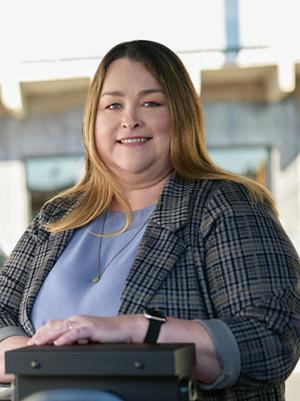 Kerri Carnes: We collaborate with partners to provide customers with devices, assist in installing devices, and call on the devices for events. Events can pre-cool homes, shifting load to our high-solar production period, and use the thermal properties of customer homes as a battery to curtail HVAC load to reduce peak demand.
Kerri Carnes: We collaborate with partners to provide customers with devices, assist in installing devices, and call on the devices for events. Events can pre-cool homes, shifting load to our high-solar production period, and use the thermal properties of customer homes as a battery to curtail HVAC load to reduce peak demand.
The APS Cool Rewards program is leading our DR portfolio. The program aggregates residential customer-owned thermostats into a growing and strategically important resource during the extreme Arizona summers, providing incentives at enrollment and an annual bill credit to participating customers.
Starting in 2018, Cool Rewards enrollment was just six thousand devices, or approximately five thousand customers. The program has scaled significantly over the years to nearly eighty thousand devices, at approximately fifty-six thousand customers, and was able to shed one hundred thirty-five megawatts of 2023 summer capacity. This energy avoidance saves customers money, benefits the environment, and builds a smarter electrical grid.
My role is to challenge the team to continue thinking about innovating the program inside the business and externally with stakeholders while keeping our customers at the center of everything we do. At the end of the day, it's always about our customer.
PUF: Elizabeth, what is your role in the development of the innovation?
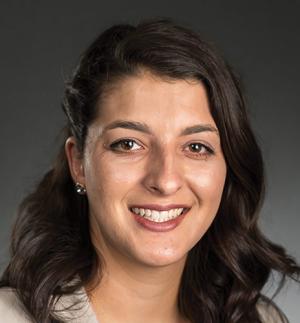 Elizabeth Lawrence: This summer we’ve dispatched our thermostats in a way that is different from what we’ve done operationally in the past. We’ll stagger dispatch of some thermostats at five o’clock and dispatch another group at six o’clock. This lets us treat the program like a power plant and extend the contribution this technology can provide to the grid.
Elizabeth Lawrence: This summer we’ve dispatched our thermostats in a way that is different from what we’ve done operationally in the past. We’ll stagger dispatch of some thermostats at five o’clock and dispatch another group at six o’clock. This lets us treat the program like a power plant and extend the contribution this technology can provide to the grid.
Elizabeth Lawrence: I've been in a fun position as this virtual power plant has grown up. Prior to moving into Customer to Grid Solutions earlier this year, I served on our state regulatory affairs team and partnered with the customer to grid solutions team as we sought regulatory approvals and enhancements to program design that allowed us to get to where we are now. I have a front row seat to this program's growth and help guide us into expanding this virtual power plant.
I started my career APS in one of our natural gas power plants. Our units at that plant ranged from fifty megawatts up to five hundred megawatts. The ones we started and stopped most frequently sat at about eighty-three megawatts.
The fact that we are delivering with smart thermostats and megawatt savings that exceed one of the units at the power plant I used to work at is exciting. This summer we've dispatched our thermostats in a way that is different from what we've done operationally in the past.
We'll stagger dispatch of some thermostats at five o'clock and then dispatch another group at six o'clock. This lets us treat the program like a power plant and extend the contribution this technology can provide to the grid.
Being part of the team that's developing how these programs bring the most value to the grid and our customers has been amazing.
PUF: Kerri, what's been most rewarding during the development of this innovation?
Kerri Carnes: I'm proud of how quickly we've scaled this program because we have intentionally kept our customers in front of everything we do when we design a program. We don't just deliver it and walk away. We check back in with customers and evolve the program with them.
After we call events, we run surveys to get just-in-time feedback from customers about their experiences and on how we can make the program better. I'm proud of the success we've had in integrating our DR portfolio as a resource with our operations teams.
I've worked at APS for over twenty years. In addition to being the former manager of state regulatory affairs, I used to lead real-time trading operations. I understand what it's like to sit at the trading desk, dispatch power plants, wait for them to come online, and ensure that all resources are lined up to meet customer demand on the hottest days of the year.
Summer's our season at APS and we're preparing year-round by sitting down ahead of the summer season with our operations teams to talk about different dispatch models. We are intentional about plugging in on a daily basis with the operations team as we're going through the summer because system conditions are ever evolving.
It's cool to see how we've evolved, how we view this as a true resource, and how these partnerships with our customers are producing one hundred thirty-five megawatts just with thermostats. Our Cool Rewards program is the biggest part of our portfolio right now and we're thinking about how we can leverage the program's successes in the future.
For example, electric vehicle adoption is growing, and we can apply what's been successful about the Cool Rewards program to the development of a managed charging program.
We get to be in this cool space inside the utility to start with the customer first and understand their challenges and needs. Then we take that art and apply the science of the reliable operation of the grid and find a way to develop mutually beneficial programs that continue to keep our customers satisfied and enrolled.
PUF: Elizabeth, what's been most rewarding in working on this innovation?
Elizabeth Lawrence: Seeing how we can supply reliable energy without starting a traditional unit. Not everyone realizes we can start our VPP and call on our customers to help meet the demand.
When I first went to school for engineering, I wanted to work in renewable energies. Now, I feel like I'm getting to work in the coolest type of energy, which is helping customers figure out how to manage their energy use in ways that work for their lifestyles while helping ensure grid reliability.
That has been rewarding in a way I didn't know was possible ten years ago. It's been great to see how the program has grown and to see what we can do next.
PUF: Jason, what's been most rewarding working on this innovation?
Jason Delaney: Our mission at APS is to serve our customers with reliable, affordable, and clean energy. With our demand response portfolio, we check all those boxes. What's most rewarding is we're just getting started and have so much potential for what we can do to power our customers and Arizona forward.
Top Innovators articles at fortnightly.com:
- Fortnightly Top Innovator Awards 2023
- Edith Clarke Top Innovator Award for Reliability: CenterPoint Energy (Resilient Digital Substation)
- Lewis Latimer Top Innovator Award for Design: Avangrid (Cybersecurity Simulation in Metaverse)
- George Westinghouse Top Innovator Award for Leadership: Southern Company (Elevate Future Fund)
- Bertha Lamme Top Innovator Award for Generation: San Diego Gas and Electric (Wildfire Next Generation System (WiNGs))
- Charles Steinmetz Top Innovator Award for Grid Operations: Exelon (Automated Drone Initiative)
- Charles Steinmetz Top Innovator Award for Grid Operations: PPL Electric Utilities (Distribution System Series)
- Nancy Fitzroy Top Innovator Award for Environment and Safety: Arizona Public Service (Innovations in Predictive Maintenance)
- Nancy Fitzroy Top Innovator Award for Environment and Safety: Xcel Energy (Drones and Robotics in Nuclear Inspections)
- Maria Telkes Top Innovator Award for Distributed Energy: Arizona Public Service Company (Virtual Power Plant)
- Maria Telkes Top Innovator Award for Distributed Energy: Puget Sound Energy (Virtual Power Plant Software Platform)
- Francis Upton Top Innovator Award for Analytics: CMS Energy (Automated Analytics for Renewable Generation)
- William Hammer Top Innovator Award for Electrification: BGE (Fleet of the Future)
- William Hammer Top Innovator Award for Electrification: Puget Sound Energy (Clean Buildings Accelerator)
- John Beggs Top Innovator Award for Energy Transition: Duquesne Light Company (Advanced Grid Solutions)
- Mabel MacFerran Top Innovator Award for Storage: PNM Resources (Battery Energy Storage Systems at Solar Sites)
- Florence Fogler Top Innovator Award for Transmission Tech: PECO (Underground Automatic Transfer Switch)


